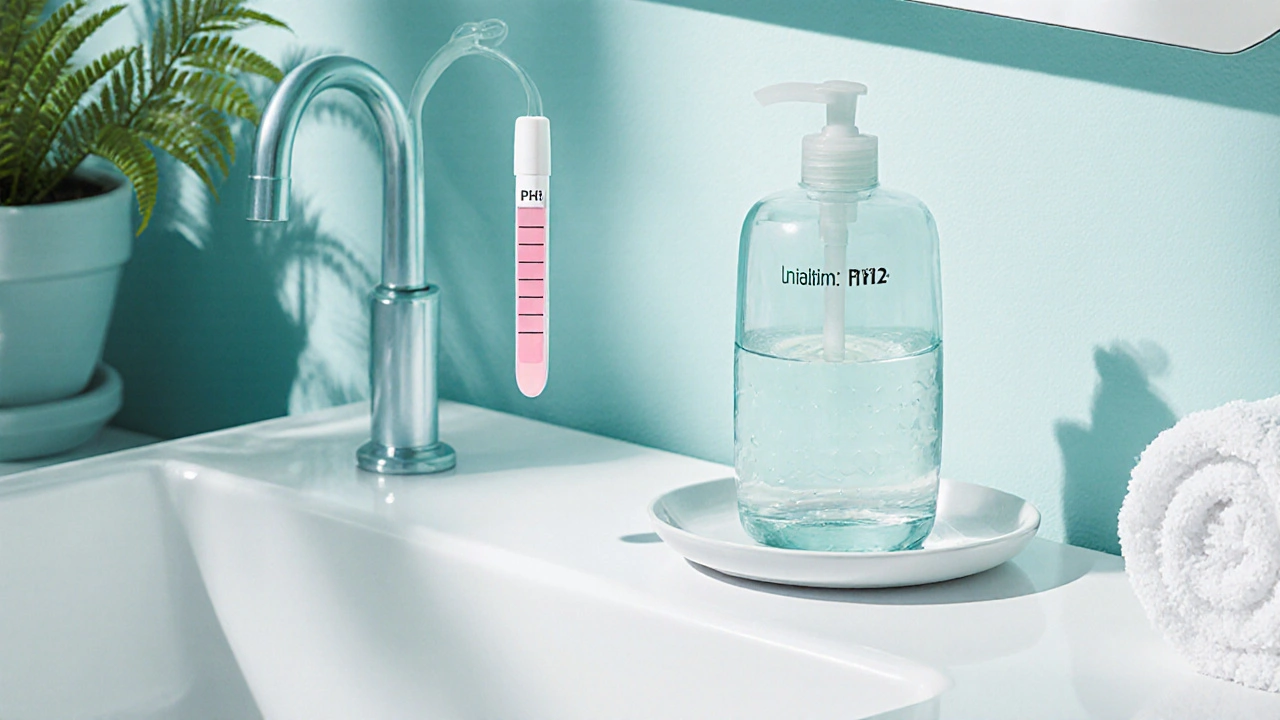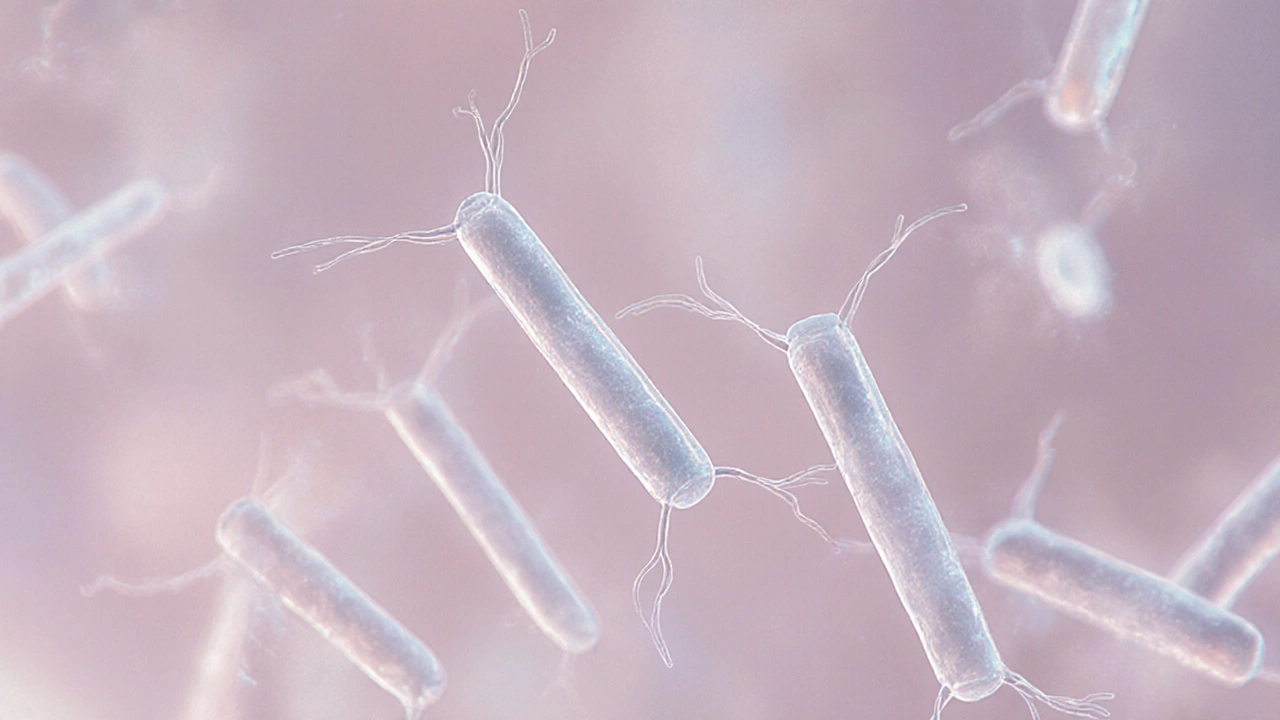Key Takeaways
- Vaginal pH normally sits between 3.8 and 4.5; staying in this range blocks harmful bacteria.
- Lactobacillus species are the main defenders - they produce lactic acid that keeps the environment acidic.
- Stress, antibiotics, douching, and tight synthetic clothing are common pH disruptors.
- Simple daily habits - proper hygiene, breathable underwear, balanced diet, and targeted probiotics - can maintain a healthy pH.
- Seek medical advice if you notice persistent odor, itching, or abnormal discharge.
Understanding Vaginal pH
When you hear the term vaginal pH is the measure of acidity or alkalinity inside the vagina, typically ranging from 3.8 to 4.5. This slightly acidic environment is a natural defense system that discourages the growth of pathogenic microbes while encouraging beneficial bacteria, especially Lactobacillus.
Think of vaginal pH as the thermostat for a tiny ecosystem. When the thermostat is set correctly, everything runs smoothly. When it drifts too high (more alkaline) or too low (overly acidic), the balance tips, and problems like bacterial vaginosis (BV) can arise.
Why pH Matters for Bacterial Vaginosis
Bacterial vaginosis is not an infection caused by a single germ; it’s a shift in the vaginal microbiome. When the pH climbs above 4.5, “good” Lactobacillus lose their grip, and anaerobic bacteria such as Gardnerella vaginalis proliferate. This overgrowth produces a fishy odor and thin, grayish discharge - classic BV signs.
Maintaining the right pH therefore acts as a preventive barrier. Research from the National Institute for Health and Care Excellence (NICE) shows that women who keep their vaginal pH in the normal range experience up to a 40% lower recurrence rate of BV after treatment.

Common Triggers That Throw pH Off Balance
- Antibiotics - while they kill harmful bacteria, they can also wipe out Lactobacillus, making the environment more alkaline.
- Douching - rinsing the vagina with water or soaps disrupts natural acidity.
- Scented products - soaps, wipes, and feminine sprays often contain alkaline chemicals.
- Tight synthetic underwear - non‑breathable fabrics trap moisture and heat, encouraging bacterial growth.
- Hormonal fluctuations - menstrual cycles, pregnancy, and menopause alter estrogen levels, which in turn affect Lactobacillus populations.
- High‑sugar diet - excess glucose feeds harmful bacteria and yeast.
- Stress - cortisol can influence hormone balance and immune response, indirectly affecting pH.
Daily Habits to Keep Your pH in Check
- Gentle cleansing: Use warm water only. If you need a cleanser, pick a fragrance‑free, pH‑balanced product (< 4.5).
- Wear breathable fabrics: Choose cotton or bamboo underwear and avoid tight leggings for extended periods.
- Stay hydrated: Adequate water intake supports natural secretions that help maintain acidity.
- Limit douching: Save rinsing for the external vulva, not the vaginal canal.
- Practice safe sex: Use condoms, change them if switching between partners, and urinate after intercourse to flush bacteria.
- Take targeted probiotics: Look for strains like Lactobacillus rhamnosus and Lactobacillus reuteri that have clinical evidence for vaginal health.
- Manage stress: Incorporate yoga, meditation, or short walks to keep cortisol levels low.
Foods and Supplements That Support a Healthy Vaginal Environment
| Category | Examples | How It Helps |
|---|---|---|
| Acid‑supporting | Yogurt (plain), kefir, fermented veggies, cranberries | Contain probiotics and natural acids that boost Lactobacillus. |
| Alkaline‑balancing | Leafy greens, cucumber, avocado, almonds | Provide minerals (magnesium, calcium) that help regulate pH. |
| High‑sugar | Sweetened drinks, candy, pastries | Feed harmful bacteria and yeast, raising pH. |
| Highly processed | Fast food, processed meats, chips | Often high in sodium and preservatives that upset microbial balance. |
Beyond foods, consider a daily supplement containing 1-2billion CFU of Lactobacillus strains specifically studied for vaginal health. Clinical trials in 2023 showed a 30% reduction in BV recurrence after a 12‑week course.

When to Seek Professional Help
Even with perfect hygiene, BV can flare up. See a GP or sexual health clinic if you notice any of the following for longer than a week:
- Persistent fishy odor, especially after sex.
- Gray‑white, thin discharge that doesn’t improve.
- Itching, burning, or soreness.
- Frequent recurrences despite lifestyle changes.
A clinician can perform a simple pH test (pH strips) and a microscopy evaluation (wet mount) to confirm BV and prescribe an appropriate antibiotic or probiotic regimen.
Quick Checklist for a Healthy Vaginal pH
- Use only water or a mild, fragrance‑free cleanser.
- Wear cotton underwear; change after sweating.
- Avoid douching and scented feminine products.
- Eat probiotic‑rich foods daily.
- Take a Lactobacillus supplement with the right strains.
- Stay hydrated and limit sugary snacks.
- Manage stress with regular relaxation techniques.
- Visit a healthcare provider if symptoms persist.
Frequently Asked Questions
What is a normal vaginal pH range?
A healthy vaginal pH typically falls between 3.8 and 4.5. Values above 4.5 can encourage growth of harmful bacteria linked to bacterial vaginosis.
Can I test my own pH at home?
Yes. Over‑the‑counter pH strips (often sold in pharmacies) allow you to swab the vaginal wall and compare the color change to a chart. For accurate results, test after urinating and before sexual activity.
Do probiotics really help prevent BV?
Research published in 2022 and 2023 shows that daily intake of Lactobacillus rhamnosusGR‑1 and Lactobacillus reuteriRC‑14 reduces BV recurrence by about one‑third compared with placebo.
Is douching ever safe?
Medical experts advise against routine douching because it strips away protective acids and can raise pH. It should only be performed under a doctor’s order for specific medical conditions.
How long does it take to restore a healthy pH after antibiotics?
It varies, but most women notice improvement within 2-4weeks when they reintroduce probiotic foods or supplements and follow the hygiene tips outlined above.


Gail Hooks
October 14, 2025 AT 22:04Thanks for sharing this detailed guide 😊 Maintaining a healthy vaginal pH really feels like caring for a tiny ecosystem, and it’s amazing how small daily choices can keep it balanced. I appreciate the emphasis on breathable fabrics and probiotic foods; they’re practical steps anyone can try. 🌿
Derek Dodge
October 24, 2025 AT 04:17i think the tip about avoiding douching is spot on though i sometimes forget.
AARON KEYS
November 2, 2025 AT 10:31This article nicely outlines both the science and the everyday habits that matter. The link between Lactobacillus and pH is clear, and the checklist at the end makes implementation straightforward.
Summer Medina
November 11, 2025 AT 16:44First let me say that the importance of pH in vaginal health cannot be overstated. The article correctly points out that a pH above 4.5 creates a perfect storm for bacterial vaginosis. Many women dont realize that everyday products like scented wipes are actually alkaline and can tip the balance. The suggestion to wear cotton underwear is simple but effective because breathable fabrics let moisture evaporate. Stress is another hidden factor that people often ignore however cortisol can shift hormone levels and indirectly raise pH. Antibiotics are a double edged sword they kill bad bugs but also wipe out the good lactobacillus making the environment more alkaline. The piece mentions high sugar diets and that is true because excess glucose feeds the harmful anaerobes. Probiotic supplements containing lactobacillus rhamnosus and reuteri are highlighted and those strains have solid clinical evidence behind them. The table comparing pH friendly and disruptive foods is useful for anyone trying to plan meals. Hydration is emphasized and that is key because water supports natural secretions that maintain acidity. The recommendation to avoid douching is consistent with major medical guidelines and should be followed by all. The checklist at the end sums up the daily habits in a clear way. I also like the suggestion to test pH at home with strips because it empowers women to monitor changes early. The article could have added a note about the role of estrogen in maintaining lactobacillus but overall it is comprehensive. Finally the reminder to seek professional help if symptoms persist is essential and should never be ignored.
Melissa Shore
November 20, 2025 AT 22:57Reading through the recommendations you can see a clear pattern that ties diet, hygiene, and stress management together into a cohesive strategy that respects the natural acidity of the vaginal environment while gently nudging it back into its optimal range whenever disruptions occur because each habit, from choosing breathable underwear to drinking enough water, plays a part in supporting the lactobacillus colonies that act as the first line of defense against bacterial vaginosis and this holistic approach feels both realistic and sustainable for everyday life, especially when considering how easy it is to incorporate probiotic foods like yogurt and kefir into regular meals without sacrificing flavor or convenience, the emphasis on avoiding douching and scented products also underscores the importance of preserving the native flora rather than attempting to artificially cleanse an ecosystem that already knows how to maintain its own balance, and finally the suggestion to seek medical advice when symptoms linger reminds us that while self-care is powerful, professional guidance remains a vital component of comprehensive vaginal health care.
Maureen Crandall
November 30, 2025 AT 05:11I totally agree the points about stress and antibiotics are often missed and adding a quick reminder about estrogen would make it even better
Michelle Pellin
December 9, 2025 AT 11:24Your elaborate synthesis is truly a masterclass in weaving together science and lifestyle, and the vivid depiction of the vaginal ecosystem as a delicate garden that thrives on careful tending is both poetic and instructive.